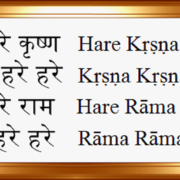Five Rites of Purification
By: Mahanidhi Swami
Any conditioned soul from any country, caste or creed can get freed from the samsara. All one needs to do is take diksha in the Gaudiya Vaisnava Sampradaya. Then by the grace of Guru and God, he/she will eventually attain Vraja prema, the eternal seva of Radha Govinda Yugala, and life eternal in the land of loving joyful play, Sridhama Vrindavana.
To achieve this perfection one must undergo five rites of purification which are called the pancha samskaras.
The word samskaras means “perfect duties.” It is a highly beneficial, purifying, and sanctifying ceremony. Its rite rests on a series of actions in harmony with metaphysical rules that manifest the invisible reality in the visible world of sense perception. Samskaras eradicate bad karma and increase the auspicious influence of material nature.
Samskaras (rites of purification for mind and body) exist in all religions and in all countries. The purer the religion is, the more its samskaras are sacred and complete. Purification rituals are needed because the original spiritual nature of every conditioned soul is covered by contamination.
Without samskaras the life of the conditioned soul remains impure. Samskaras are rites of sanctification which purify the consciousness, attach one to God, and ultimately lead to prema. Performing a samskara renders an individual fit to execute a particular duty. Prescribed in various Vedic texts, the samskaras are a series of about ten physical and mental purification rites beginning from birth and ending at death.
Gaudiya Vaisnavas accept five sacraments or rites of purification (panca-samskaras). Upon adopting these panca-samskaras, a faithful person receives Gaudiya Vaisnava diksha and begins his life of Radha-Krishna worship, bhajana-kriya, the personal worship of God which eventually leads to pure love of Krishna.
These five sacraments have both internal and external aspects. Tapa, pundra, nama, mantra, and yaga—these five rites are the panca-samskaras. They are the basis of intense devotion to Lord Hari.
1) Tapa—using sandalwood paste or tilaka to write the holy names on the body: Jaya Gaura-Nitai, Hare Krishna, Sri Radhe, and so on. Tapa also includes internal cleansing of the heart by repentance, and developing a genuine aversion to material life.
2) Urdhva-pundra—marking the body with the tilaka symbols of your particular Gaudiya lineage to designate it as a temple for the Lord’s service. The tilaka symbol represents Krishna’s footprint. Seeing it, the devotee thinks, “I have Krishna’s footprint on my head. He is my eternal master, and I am His eternal servant. In all times, places, and circumstances I have an eternal relationship with Krishna.” In a broader sense, urdhva-pundra means all the things related to one’s identity as an eternal servant of Krishna, such as neck beads, dhoti, sari, andjapa mala. Urdhva-pundra also means the illumination of the body, mind, soul and attachment to the Supreme Lord.
3) Nama—receiving the name of Hari (Hare Krishna maha-mantra) in the ear from the preceptor and a spiritual name as Krishna’s servitor like Radha-carana dasa or Priyaji dasi. By taking shelter of the holy names, (and his diksha mantras), and by practicing intense devotional bhajana a disciple will taste the nectar of bhakti, realize his spiritual identity and rejoice in devotional service.
4) Mantra—receiving the eighteen-syllable Gopala-mantra from the spiritual master. By giving a mantra the teacher helps his student more easily experience the nectar of the holy name. The mantra also helps the disciple taste a particular flavor or mellow in the holy name of Krishna.
5) Yaga—utilizing the guru-given mantras to worship Sri Murti or Salagrama. Such puja purifies and protects the devotee from the danger of falling into maya. Yaga, the fifth and final samskara, is the procedure of worshiping the Lord by employing all the mental and physical faculties of meditation, seeing, touching, smelling, tasting, thinking, discriminating and acting. A person without yaga has no life, and he is forced to reap the results of his karma.
“Without accepting the panca-samskara system a conditioned soul cannot develop intense devotion to Lord Krishna. Therefore, panca-samskara is extremely necessary.” (Srila Bhaktivinoda Thakura)
Our next article will define and describe the rite of initiation into sacred mantras, diksha.
(Excerpt from book Gayatri Mahima Madhuri by Mahanidhi Swami)
Jai Jai Sri Radhe!






Leave a Reply
Want to join the discussion?Feel free to contribute!